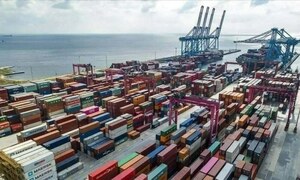Oil prices soared on Friday after oil producers agreed to modest crude output increases to compensate for losses in production at a time of rising global demand. The Organization of the Petroleum Exporting Countries and other top crude producers, meeting in Vienna, agreed to raise output from July by about 1 million barrels per day (bpd).
The real increase, however, will be around 770,000 bpd, according to Iraq, because several countries that recently suffered production declines will struggle to reach full quotas, while other producers may not be able to fill the gap. The actual output increases set a bullish tone, as they came in below some of the highest figures that had been discussed prior to the meeting.
"There was a lot of anticipation in the market that there was going to be a lot of new oil coming to market, and that isn't going to happen, at least for now," said John Kilduff, a partner at Again Capital. "We were teased with an increase of about 1.8 million barrels (per day) at one point, and we ended up getting about 600,000," Kilduff said.
Brent crude settled up $2.50, or 3.4 percent, to $75.55 a barrel, supported by the Opec announcement. US crude rose $3.04, or 4.6 percent, to $68.58 a barrel, after a surprise large decline of oil supplies at the storage hub at Cushing, Oklahoma. Brent crude was up 2.7 percent on the week, while US crude was up 5.5 percent.
For about three weeks ahead of the meeting, prices had retreated from 3-1/2-year highs on fears that larger production increases could lead to oversupply. Ultimately, Saudi Arabia persuaded Iran to cooperate with the plan to cut output, following calls from major consumers to curb rising fuel costs. Opec's decision confused some in the market as the producers gave opaque targets for the increase, making it difficult to understand precisely how much more it will pump. The expectation that the increase will fall short of the 1 million bpd figure boosted the market.
"The effective increase in output can easily be absorbed by the market," Harry Tchilinguirian, head of oil strategy at French bank BNP Paribas, told the Reuters Global Oil Forum. "You think about 1 million bpd coming back online ... it's not going to happen instantaneously, it's going to take time," said Brian LeRose, the senior technical analyst at ICAP.
International marker, Brent, traded above $100 a barrel for several years until 2014, dropping to almost $26 in 2016 and then recovering to over $80 last month. The most recent price rally followed an Opec decision to restrict supply in an effort to drain global inventories.
The group started withholding supply in 2017 and this year, amid strong demand, the market tightened significantly, triggering calls by consumers for higher supply. Falling production in Venezuela and Libya, as well as the risk of lower output from Iran as a result of US sanctions, have all increased market worries of a supply shortage.
Another big uncertainty for oil is the escalating fight between the United States and its trading partners, which could hit US crude oil exports to China. If a 25 percent duty on US crude imports is implemented by Beijing, American oil would become uncompetitive in China, forcing it to seek buyers elsewhere. Chinese buyers are already starting to scale back orders, with a drop in supplies expected from September.
Front-month US crude futures extended their rally during the session, trading as much as $1.51 a barrel above the second month contract
Storage has fallen as Gulf Coast refiners have soaked up crude that was available at a discount, said Bob Yawger, director of Energy at Mizuho. The result is lower inventories at the hub for at least seven weeks, he said. US drillers cut the number of rigs drilling for oil by one to 862, the first cut in 12 weeks, according to a weekly report from GE's Baker Hughes division. The rig count is a leading indicator of production.
BR100
11,841
Decreased By
-24.6 (-0.21%)
BR30
35,821
Increased By
124.3 (0.35%)
KSE100
113,807
Decreased By
-341.4 (-0.3%)
KSE30
35,838
Decreased By
-114 (-0.32%)

























Comments
Comments are closed.